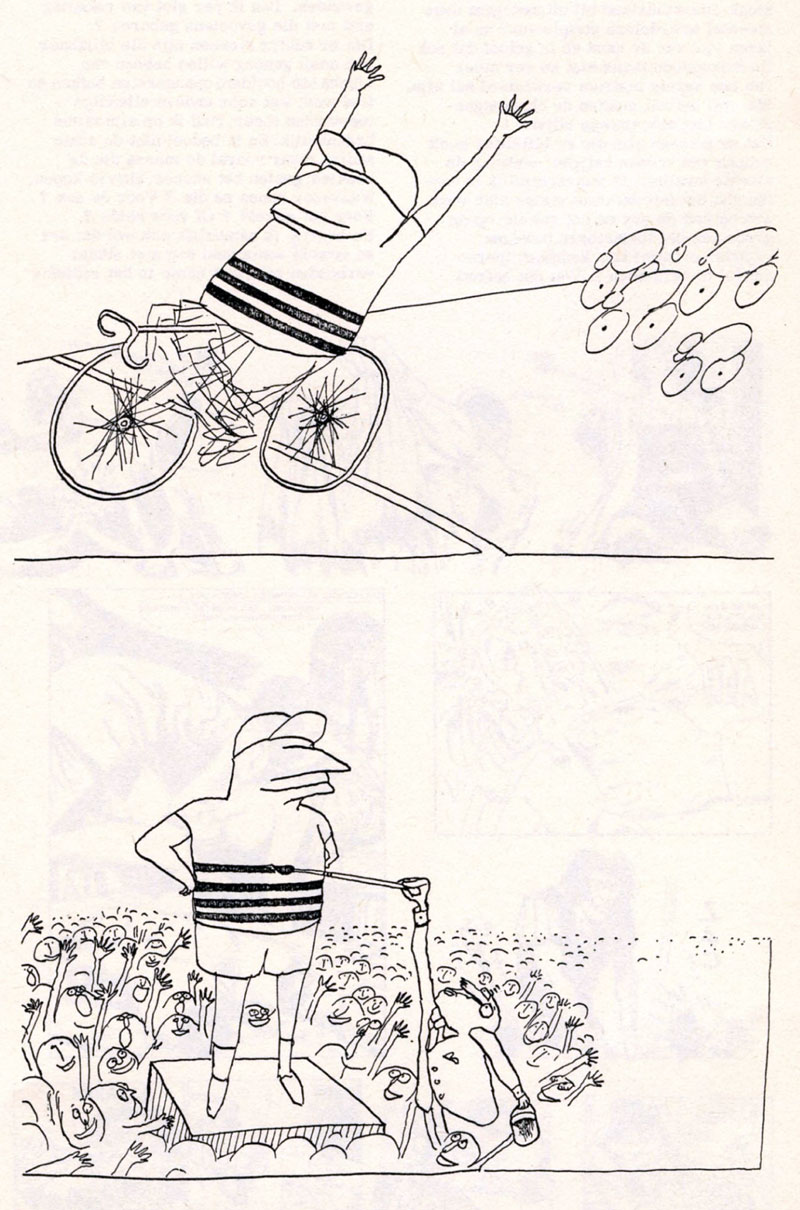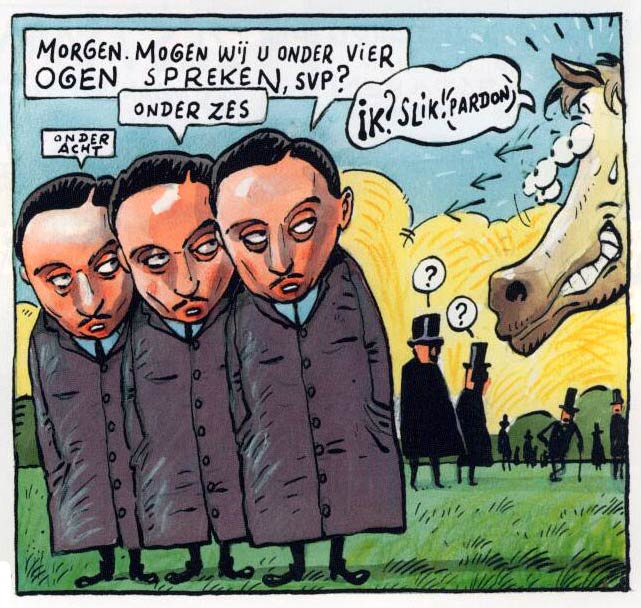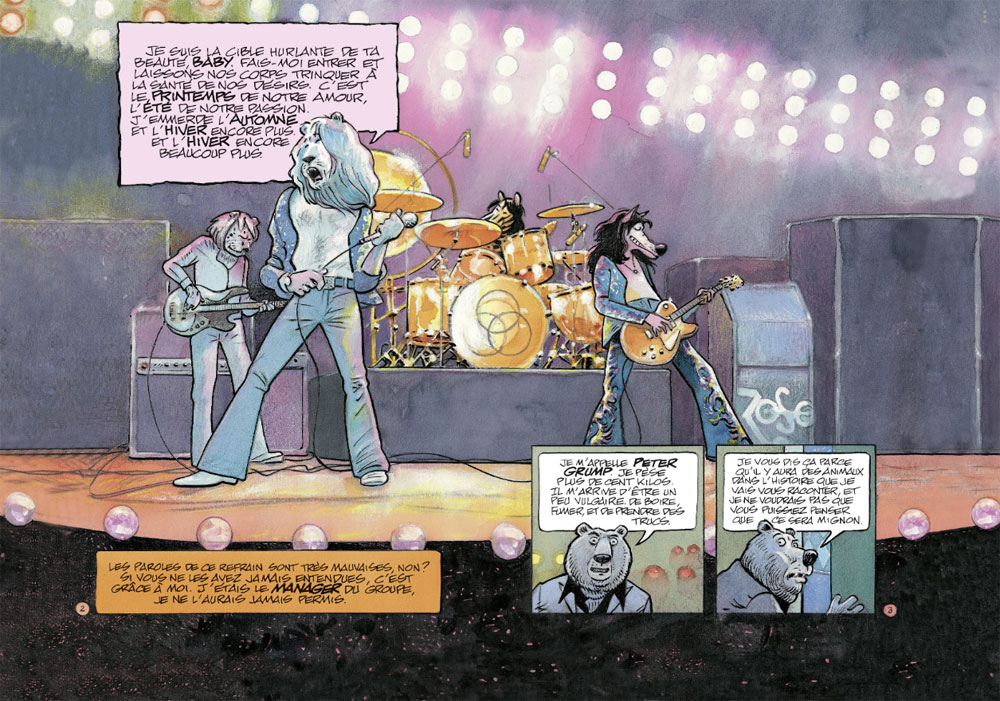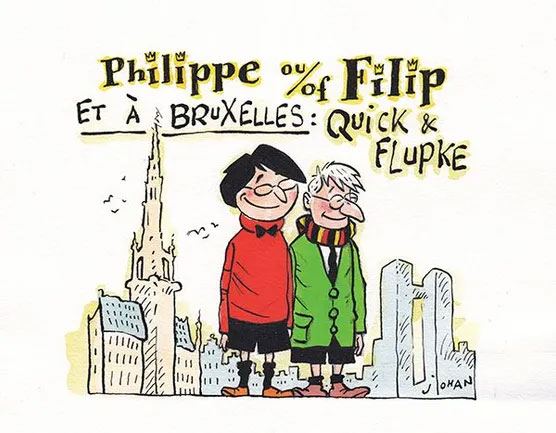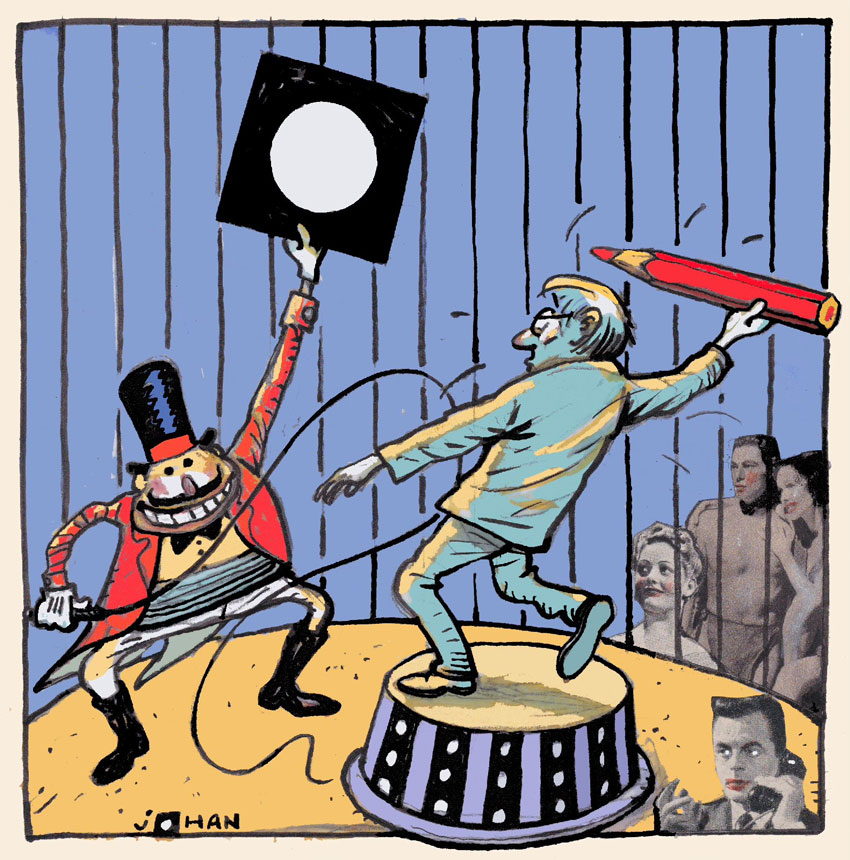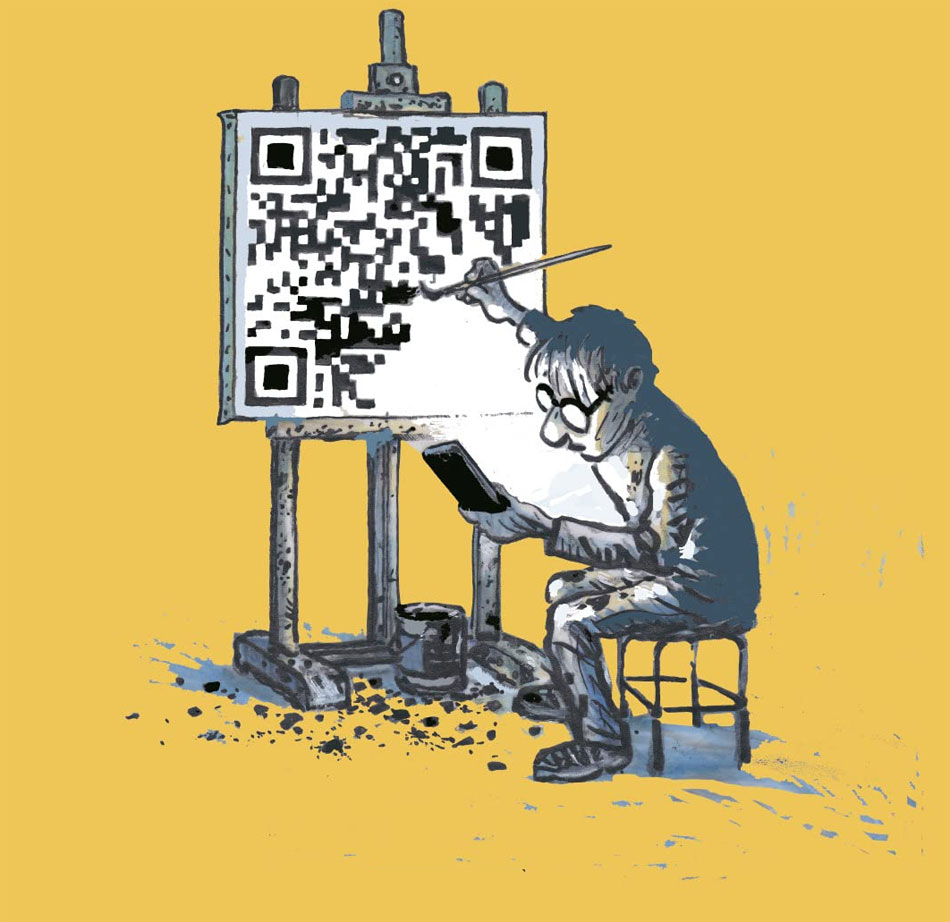'La Vache'. Dutch-language version: 'De Koe'.
Johan De Moor is a Belgian political cartoonist and comic artist. During the 1980s, he worked with his father Bob De Moor at Studio's Hergé, where he was responsible for both the animated TV series and new comic stories with Hergé's 'Quick et Flupke' characters. After the studio was dissolved, De Moor embarked upon a solo career, working with writer Stephen Desberg on the comic series 'Gaspard de la Nuit' (1987-1991) and 'La Vache'/'Lait Entier' (1992-2002), and co-creating several one-shot graphic novels. His political cartoons have appeared in PAN and Le Soir, while he has also become known as a radio personality and a teacher of Comic Art at the Sint-Lukas School of Arts in Brussels.
Early life and career
Johan De Moor was born in 1953 in Wilrijk, Antwerp, as the third son of the famous Belgian comics artist Bob De Moor. His older brothers Chris and Dirk later became an opera singer and a conductor, respectively. After Johan came a sister, Annemie, and another brother, Stefaan. When he was two years old, the family moved to Uccle, one of the Brussels suburbs. From an early age, Johan De Moor grew up amidst comic legends. His father worked for Hergé and was close friends with Willy Vandersteen, who was even Johan's godfather. Other artists who frequented the De Moor household were Edgar P. Jacobs, Paul Cuvelier and Jacques Martin. One of Johan's childhood friends was the future comic writer Stephen Desberg, with whom he shared a taste for classical music and went to the college choir of his Jesuit school.
Johan De Moor studied Graphic Arts at the Sint-Lukas Institute in the Dutch-speaking section of Schaerbeek and at La Cambre in Brussels. One of his fellow students was Thierry Culliford, the son of Peyo. He then studied lithography, wood engraving and etching at the Le 75 art school in Woluwe-Saint-Lambert, and had internships in Italy and Portugal, where he painted several murals shortly after the Carnation Revolution. While De Moor has been influenced by his father, Vandersteen and Hergé, he tried to find his own path. As an artist, he underwent additional influence from underground comix and contemporary artists like Ever Meulen and Gal, while he has also named the painters Hieronymus Bosch and Pieter Bruegel the Elder as important inspirations.
The cartoon that won Johan De Moor the 1975 Kartoenale contest.
Cartoonist
Instigated by the Belgian cartoonist Gal, one of his teachers at Saint-Luc, De Moor decided to become a political caricaturist. During the early 1970s, he began submitting his work to cartoon contests, and was among the winners of the 1975 Wereldkartoenale in Knokke-Heist. The jury compared his pencil drawings to the paintings of Francis Bacon and the drawings of Ralph Steadman. Starting in 1978, he published his cartoons in the socialist newspaper De Morgen, and subsequently also made cartoons for the cultural non-profit organization Het Masereelfonds. In 1984, a selection of his cartoons was collected in the landscape-format booklet 'Vijf Voor Twaalf', the fourth installment in the series 'Kartoenklassieken' of publisher De Dageraad, which had previously compiled work of Pil, Brasser and Cram.
Studio's Hergé
By the early 1980s, Johan De Moor eventually ended up working with his father. In 1980, he had a three-month trial period at Studio's Hergé, drawing locomotives and aircrafts for the reprints of two volumes in the educational book series 'Voir et Savior' for Septimus Éditions. He was subsequently hired, and began working with his father on advertisements, posters and other commercial art work with the 'Tintin' characters. He also helped his father with the coloring of the 1982 episode of his naval comic series 'Cori de Scheepsjongen', 'Koers naar het Goud'. When Hergé died in 1983, it became clear that no new 'Tintin' comics were to be produced.
Instead, Johan De Moor tried his hand at one of Hergé's 1930s comics, starring the Brussels rascals 'Quick et Flupke'. De Moor was charmed by the comic's archaic look and feel, and proposed a series of animated TV shorts with the characters. When Hergé's heirs greenlighted the project, De Moor set out to work on the project in collaboration with the Atelier Graphoui production studio. De Moor served as scriptwriter and artistic director for all 260 cartoons, which were typically only one minute long. Some were adaptations of earlier comic episodes, other scripts were new. Together with his main collaborator Pjotr (Piet De Ruyker), De Moor chose for a more loose, fluid and cartoony style than Hergé was known for. The catchy musical intro and outro were composed by Pierre Zurstrassen. Between 1984 and 1986, 'Quick & Flupke' was broadcast on the Walloon public channel RTBF, the Flemish public channel BRT 1 (nowadays the VRT), the Dutch public channel VARA and the French public channel Antenne 2 (nowadays France 2).
The broadcasts of the 'Quick & Flupke' cartoons sparked off new interest in the original comic series, which led to reprints of all books by publisher Casterman. In addition, Johan De Moor received permission to adapt some of the TV episodes into new comic stories. Additional episodes were written exclusively for the comics themselves by Roger Ferrari. De Moor mimicked the original drawing style so naturally, that even fans couldn't tell it wasn't Hergé's original art. The 'Quick & Flupke' gags by Johan De Moor can be found in two albums: 'Haute Tension' ('High Tension', 1985) and 'Jeux Interdits' ('Double Trouble', AKA 'Forbidden Games', 1985).
In late 1986, the Studio's Hergé were dissolved, and both father and son De Moor could embark upon personal projects. In 1992, Bob De Moor passed away, leaving his final 'Cori de Scheepsjongen' story unfinished. With help of his friend and scriptwriter Stephen Desberg, Johan De Moor produced the rest of the story, published in 1993 under the title 'Dali Capitan'.
'Gaspard de la Nuit'. Dutch-language version.
Gaspard de la Nuit
After leaving Studio's Hergé, Johan De Moor teamed up with his childhood friend Stephen Desberg to create the fantasy adventure series 'Gaspard de la Nuit' (Casterman, 1987-1991). Named after the piano suite by Maurice Ravel, the series was filled with fantasy creatures, mystery and parallel universes, rooted in traditional Flemish fantasy tales and legends. In the debut story, an eight-year old boy called Gervais enters a mysterious dispensary, where a collection of masks on the wall seems to observe him. One of them is of a slightly older boy, who asks for his help. When Gervais takes the mask home and puts it on, he turns into the other boy, known as "Gaspard de la Nuit" ("Gaspard of the Night"). From then on, the dreamy hero's reality changes. He can choose between the world of the humans - devoid of fantasy and whose existence seems devoted to work - and that of the small people of the night, where musicians, actors, elves, dragons and unicorns gather. He chooses the latter, kicking off a series of baroque fantasy adventures. The first three books formed an ongoing coming-of-age narrative, in which Gaspard searches for his own identity, the fourth installment was a stand-alone story. 'Gaspard de la Nuit' appeared in Dutch under the title 'Kasper', and was serialized in Eppo/Wordt Vervolgd and Sjors en Sjimmie Stripblad.
'La Vache'. Dutch-language version.
La Vache
While creating 'Gaspard de la Nuit', Johan De Moor had gradually found a more personal style, freed from the Clear Line influences of Hergé and his father. For his next comic, he turned to even more graphic experiments. Again with Stephen Desberg, he created 'La Vache' (1992-2002), a funny animal series about a seemingly ordinary milk cow, who leads a double life as a secret agent with the codename Pi 3.1416. In each episode, she has to save the world from great disaster, while the stories combine humor and satire with philosophy and emotions. In this series, Johan de Moor showcased his graphic abilities with a collage style, combining old clippings of advertisements with African art influences, while playing with the lettering and the coloring.
After their initial serialization in (A Suivre) magazine (1992-1997), the stories were collected in book format by Casterman - the first one in a small format, the seven additional volumes in a regular size. In 2001, De Moor and Desberg took their comic to publisher Le Lombard, where they created two further albums under the new series title 'Lait Entier' (2001-2002). In 1995, the comic was first translated into Dutch by Johan Anthierens, who came up with the title 'Kobe de Koe'.
A 19-page epilogue story with La Vache was printed in the 1 May 2015 issue (#52) of the monthly magazine L'Immanquable.
'Coeur Glacé'. The monster peering over the wall is a nod to Gustave Doré's big-eyed gnarled monster from his illustrations to 'The Days of Chivalry, or the Legend of Croquemitaine' by Ernest L'Épine. In the back appears Stephen Hillenburg's 'SpongeBob Squarepants.'
Later comics
In 2004, De Moor participated in a new comic series that served as a four-volume sequel to Rudyard Kipling's classic novel 'Jungle Book'. In 'Le Dernier Livre de la Jungle' (Lombard, 2004-2007), an elderly Mowgli returns to the jungle of his childhood, where he looks back on his time living with the animals. Written by Desberg, the pencil art was done by Henri-Joseph Reculé, with De Moor taking care of the inking and coloring of the first two books. With writer Jean-Pierre Verheggen, De Moor created the picture book 'Le 12 Septembre' (Lombard, 2005), about Douce Septembre, a baby found in the debris of the Twin Towers the day after the 9/11 catastrophe.
Together with the Belgian humorist and broadcaster Gilles Dal, De Moor created 'Coeur Glacé' (Lombard, 2014), a graphic novel full of surreal imagery, about a middle-aged man overthinking his life. It was first serialized in the monthly magazine L'Immanquable. In 2016, they released the follow-up 'La Vie à Deux', in which the authors gave their destabilizing and wacky vision on life as a couple. Six years later, De Moor joined Stephen Desberg again for 'Les Sauvages Animaux' (Casterman, 2022), the fictional biography of a 1970s group of animal rockers.
'Les Sauvages Animaux' (2022).
Return to cartoons
By the time his comic series had come to an end, Johan De Moor returned to his first job as a cartoonist. Signing with simply "Johan", he has been a regular contributor to the satirical magazine PAN, and has also appeared on the Satiricon website, in Pandora magazine and in the newspaper Le Soir, where he has filled in for his cartoonist friend Pierre Kroll. Between 2004 and 2008, Johan De Moor also appeared in the pages of Spirou magazine as one of the illustrators of the section 'Docteur je sais tout' by Martin Winckler. During this period, he also had a brief appearance in Fluide Glacial magazine, creating a short story and a couple of gag pages with Sergio Salma.
Cartoon spoofing Hergé's 'Quick & Flupke' characters, with Belgian Prime Minister Elio Di Rupo and king Filip/Philippe.
In his political cartoons, De Moor frequently uses classic Belgian comic characters or parodies of classic Belgian comic stories in a satirical context. Even imagery from Hergé's comics is often spoofed, despite Hergé's estate usually suing people and organisations for copyright infringement. But De Moor always avoids any legal trouble, presumably thanks to his late father's direct connection to Hergé. As a press cartoonist, De Moor observes the absurdities and injustices of our modern times, using a mix of graphic techniques. Later collections of his press illustrations have been 'Je Sais Tout' (Points Image, 1994) and 'Dessins d'Humeur' (Casterman, 2022).
Johan De Moor is one of many cartoonists associated with the collective and website The Cartoonist, established by Marec, where Belgian cartoonists make their archived and new work available to the public.
Cartoon of 8 June 2024, about the Belgian federal elections.
Graphic contributions
As a bilingual, Johan De Moor is one of the few Flemish comic artists whose work has appeared both in Flanders and Wallonia, and who has contributed to collective projects on both sides of the language border. In 1993, De Moor was one of several former Bronzen Adhemar award winners to pay a graphic tribute to Marc Sleen in the book 'Marc Sleen. Een Uitgave van de Bronzen Adhemar Stichting' (Standaard Uitgeverij, 1993). Over the years, De Moor has appeared in collective comic books about football ('C'est Fou le Foot sans les Règles' by Pictoris Studio, 1998), the new millennium ('La BD du 3e' by Loterie Romande, 1999) and suicide prevention ('Vivre?' by the Center of Suicide Prevention, 2010). He also appeared in the third volume of the collective cartoon series 'Monsieur Mouche' (Zanpiano, 2006) by Jean-Luc Coudray.
Johan De Moor was part of a selection of Belgian cartoonists to make special cartoons and comics for Gilles Dal’s book "België, Et Cetera" (Van Halewyck, 2016), a funny look at the history of Belgium. In 2020, he joined 75 Dutch & Flemish comic artists to make a graphic contribution to the free collective comic book 'Striphelden versus Corona' (Oogachtend, Uitgeverij L, 2020), a publication in support of comics stores that had to close their doors during the lockdowns at the height of the COVID-19 virus pandemic.
Cartoon by Johan De Moor, depicting King Albert II writing his 2008 Christmas speech with suppressed anger, which won De Moor the Press Cartoon Belgium.
Recognition
In 1989, Johan De Moor won the Bronzen Adhemar, the official Flemish Community Cultural Prize for Comics. De Moor also won the Grand Prix at the Festival BD Sierre. For the second album of 'La Vache', De Moor and Stephen Desberg received a prize for "Best Humor Story" at the 1995 Comic Festival of Angoulême, France. In 2002, he was awarded no less than three times: the prize for the Flemish Community in Brussels, the prize of Flemish Comic Artists and the Golden Pen Diploma, awarded by the non-profit organization 9ème Art.
As an editorial cartoonist, De Moor has been regularly awarded, starting with his 1975 prize during the Kartoenale in Knokke-Heist. In 2008, he won the Press Cartoon Belgium Award for a cartoon published in the magazine Pan. It depicted Belgian king Albert II working late at night on his Christmas speech, trying to suppress his anger at the politicians unable to form a government. In 2019, De Moor won the same award with a cartoon referencing the #metoo movement: it depicts a beer card and a spoof of the slogan "Men know why" by beer brand Jupiler. In 2024, De Moor won the Press Cartoon Belgium Award a third time. His cartoon, posted on the website Satiricon.be, commented on the police raids near the South Station in Brussels. The drawing shows the station in pink, rosy colors, "cleaned up" by a Barbie doll, while the deeper root of the problems hasn't been resolved.
In 1998, he was responsible for the decoration of the Belgian pavilion at the World Expo in Lisbon, Portugal, which had water as a theme. In May 2013, De Moor exhibited a series of acrylic paintings at the Galerie Petits Papiers au Sablon in Brussels.
Parody of Dutch painter Johannes Vermeer's 'Het Melkmeisje' ('The Milk Maid').
Teacher and promoter
Between 1998 and 2008, Johan De Moor was one of the driving forces behind the Comics section of the Dutch-language Sint-Lukas School of Arts in Brussels. He established the course together with Nix, and trained such young artists as Olivier Schrauwen, Simon Spruyt, Conz and Judith Vanistendael. Nix taught how to write short humor comics, while De Moor gave drawing lessons and Jan Bucquoy trained the students in writing longer scripts. At the 2004 Angoulême Festival, De Moor, Nix and their students organized a frivolous exposition, set in a vintage classroom.
For their students, Nix and De Moor also launched initiatives like the annual magazine Demo, the anthology 'Bruxxxel' (2005), and an exposition in Kees Kousemaker's Gallery Lambiek in Amsterdam in June 2003. Between April and September 2021, De Moor was co-curator of the exhibition 'United Comics of Belgium', a collective exhibition of 27 Belgian comic book authors representing Belgian creativity in 2020 at the Belgian Comic Strip Center in Brussels.
In 2003, students of the Sint-Lukas in Brussels exhibited their work in Gallery Lambiek, on the occasion of the 5th anniversary of the school's Comics section. The event was organized by the teachers Johan de Moor (third from the left) and Nix.
Radio personality
In later years, De Moor also appeared in other media. At the end of 2009, he was hired as a columnist on the humorous RTBF radio show 'Le Jeu des Dictionnaires', where he has appeared alongside Pierre Kroll, Thomas Gunzig, Fred Jannin, Gilles Dal, Juan D'Oultremont, Bruno Coppens and Eric De Staercke. He has also participated in the radio comedy show 'La Semaine Infernale' ("Hell Week"), which gives a satirical and critical look at the news of the week. Between 2016 and 2018, he was also a columnist on the radio show 'Un Samedi d'Enfer', broadcast on Saturdays on the La Première channel of RTBF.
Legacy
In March-April 1999, Johan De Moor and Stephen Desberg's 'La Vache' was honored with a comic book wall, located at the Rue du Damier/Damstraat 23, as part of the Brussels Comic Book Route. The mural was designed by E. d'Hainaut, G. Oreopoulos and D. Vandegeerde. On 12 December 2008, De Moor designed another comic book wall at the Place Victor Horta/Victor Hortaplaats in Brussels, depicting numerous comic characters running out of a comic book.
Johan De Moor has been named an influence by Jeroen Janssen. Another celebrity fan of his cartoon work is the Belgian singer Arno, who invited the cartoonist and his colleague Nix to draw live during his 31 January 2009 concert. Johan De Moor's son Thomas (b. 1979) has made television documentaries, and has also worked as a visual artist, videographer and musician.
Self-portrait for the cover of Johan De Moor's 2022 cartoon book 'Dessins d'Humeur'.




